Miead Tehrani-Moayyed
AI-assisted Agile Propagation Modeling for Real-time Digital Twin Wireless Networks
Oct 29, 2024Abstract:Accurate channel modeling in real-time faces remarkable challenge due to the complexities of traditional methods such as ray tracing and field measurements. AI-based techniques have emerged to address these limitations, offering rapid, precise predictions of channel properties through ground truth data. This paper introduces an innovative approach to real-time, high-fidelity propagation modeling through advanced deep learning. Our model integrates 3D geographical data and rough propagation estimates to generate precise path gain predictions. By positioning the transmitter centrally, we simplify the model and enhance its computational efficiency, making it amenable to larger scenarios. Our approach achieves a normalized Root Mean Squared Error of less than 0.035 dB over a 37,210 square meter area, processing in just 46 ms on a GPU and 183 ms on a CPU. This performance significantly surpasses traditional high-fidelity ray tracing methods, which require approximately three orders of magnitude more time. Additionally, the model's adaptability to real-world data highlights its potential to revolutionize wireless network design and optimization, through enabling real-time creation of adaptive digital twins of real-world wireless scenarios in dynamic environments.
Colosseum as a Digital Twin: Bridging Real-World Experimentation and Wireless Network Emulation
Apr 13, 2023



Abstract:Wireless network emulators are being increasingly used for developing and evaluating new solutions for Next Generation (NextG) wireless networks. However, the reliability of the solutions tested on emulation platforms heavily depends on the precision of the emulation process, model design, and parameter settings. To address, obviate or minimize the impact of errors of emulation models, in this work we apply the concept of Digital Twin (DT) to large-scale wireless systems. Specifically, we demonstrate the use of Colosseum, the world's largest wireless network emulator with hardware-in-the-loop, as a DT for NextG experimental wireless research at scale. As proof of concept, we leverage the Channel emulation scenario generator and Sounder Toolchain (CaST) to create the DT of a publicly-available over-the-air indoor testbed for sub-6 GHz research, namely, Arena. Then, we validate the Colosseum DT through experimental campaigns on emulated wireless environments, including scenarios concerning cellular networks and jamming of Wi-Fi nodes, on both the real and digital systems. Our experiments show that the DT is able to provide a faithful representation of the real-world setup, obtaining an average accuracy of up to 92.5% in throughput and 80% in Signal to Interference plus Noise Ratio (SINR).
CaST: A Toolchain for Creating and Characterizing Realistic Wireless Network Emulation Scenarios
Aug 08, 2022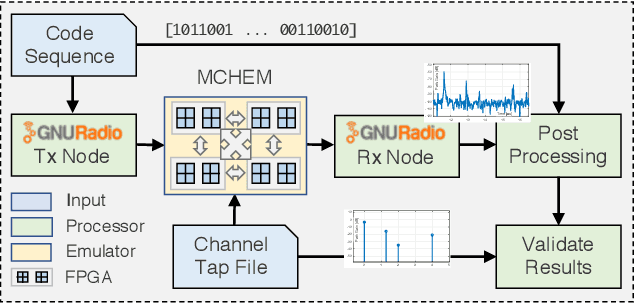

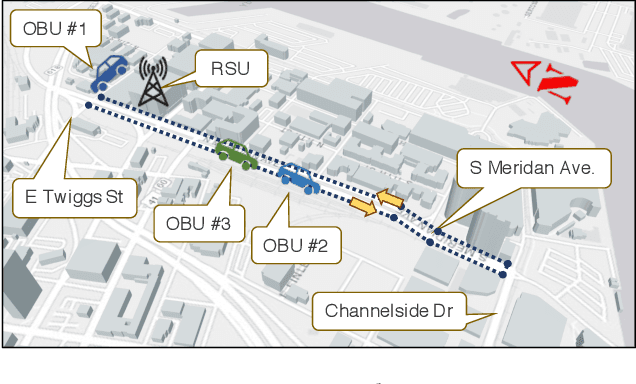
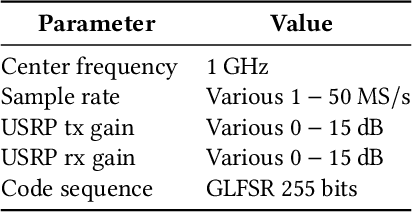
Abstract:Large-scale wireless testbeds have been extensively used by researchers in the past years. Among others, high-fidelity FPGA-based emulation platforms have unique capabilities in faithfully mimicking the conditions of real-world wireless environments in real-time, at scale, and with full repeatability. However, the reliability of the solutions developed in emulated platforms is heavily dependent on the emulation precision. CaST brings to the wireless network emulator landscape what it has been missing so far: an open, virtualized and software-based channel generator and sounder toolchain with unmatched precision in creating and characterizing quasi-real-world wireless network scenarios. CaST consists of (i) a framework to create mobile wireless scenarios from ray-tracing models for FPGA-based emulation platforms, and (ii) a containerized Software Defined Radio-based channel sounder to precisely characterize the emulated channels. We design, deploy and validate multi-path mobile scenarios on the world's largest wireless network emulator, Colosseum, and further demonstrate that CaST achieves up to 20 ns accuracy in sounding the Channel Impulse Response tap delays, and 0.5 dB accuracy in measuring the tap gains.
Colosseum: Large-Scale Wireless Experimentation Through Hardware-in-the-Loop Network Emulation
Oct 20, 2021
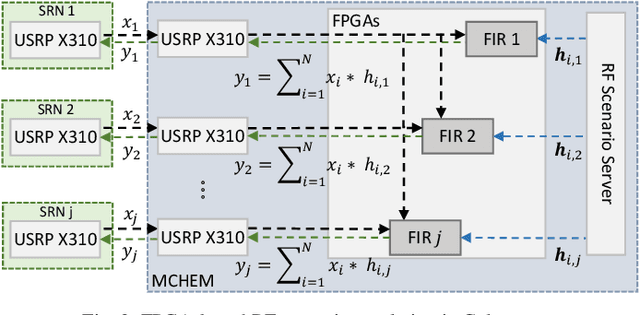
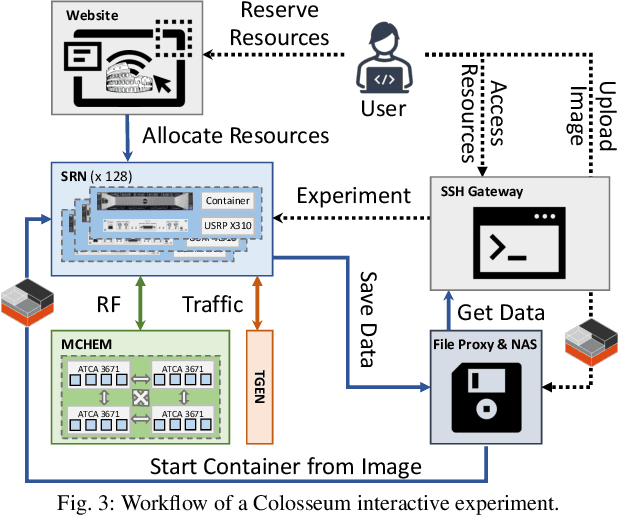
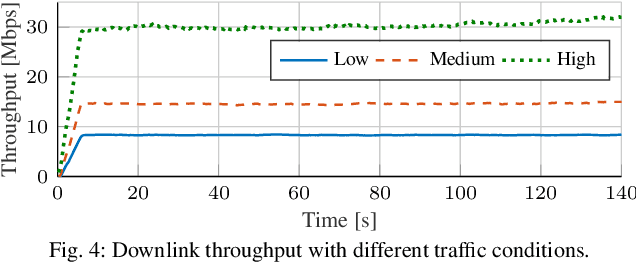
Abstract:Colosseum is an open-access and publicly-available large-scale wireless testbed for experimental research via virtualized and softwarized waveforms and protocol stacks on a fully programmable, "white-box" platform. Through 256 state-of-the-art Software-defined Radios and a Massive Channel Emulator core, Colosseum can model virtually any scenario, enabling the design, development and testing of solutions at scale in a variety of deployments and channel conditions. These Colosseum radio-frequency scenarios are reproduced through high-fidelity FPGA-based emulation with finite-impulse response filters. Filters model the taps of desired wireless channels and apply them to the signals generated by the radio nodes, faithfully mimicking the conditions of real-world wireless environments. In this paper we describe the architecture of Colosseum and its experimentation and emulation capabilities. We then demonstrate the effectiveness of Colosseum for experimental research at scale through exemplary use cases including prevailing wireless technologies (e.g., cellular and Wi-Fi) in spectrum sharing and unmanned aerial vehicle scenarios. A roadmap for Colosseum future updates concludes the paper.
 Add to Chrome
Add to Chrome Add to Firefox
Add to Firefox Add to Edge
Add to Edge